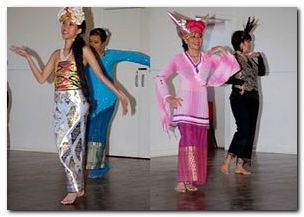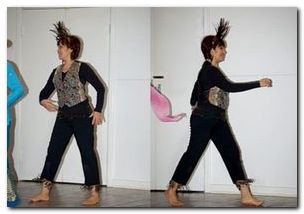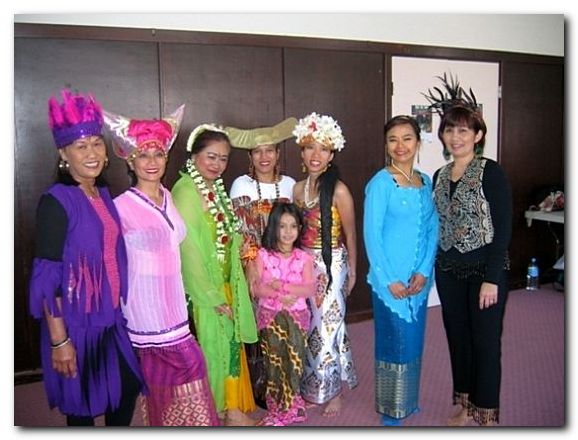Indonesian women in Perth perform a ‘uniting’ dance
Monika Swasti Winarnita
Selendang Sutra dancers in various traditional costumes for the Unity in Diversity dance.
|
Anna is a dancer from an Indonesian dance group called Selendang Sutra (Silk Veil), based in Perth, Western Australia. Most of the dancers in Selendang Sutra are Indonesian citizens but are permanent residents of Australia with Anglo-Australian partners. Their main occupation is as housewives but some work and study also.
For these women, dancing began as an interesting and challenging pastime but the group developed to the point where they started performing and it is now one of several active Indonesian dance groups in Perth. Multicultural festivals, which occur regularly throughout the city, provide stages for their performances. They also perform at events run by the Indonesian consulate, which caters to the 10,000 strong Indonesian community.
Among the dances the group performs is one that takes Indonesia’s national motto, Unity in Diversity, as its name. When the dancers perform this dance, they feel patriotic. But they no longer perform it at ‘Indonesian only’ events.
Dancing as migrants
Suburbs like Victoria Park and those in the inner south of the Swan River, which have high concentrations of Indonesian migrants, provide a full range of amenities including a supermarket, restaurants, a hairdresser, massage and beautician services and a car rental agency, all owned and run by Indonesians. There are even churches where services are held in Indonesian language. It is not surprising then, that when Anna arrived in Perth in 2002 she found that many Indonesian migrants were involved almost exclusively in their own community. Like her compatriots, Anna lives a very Indonesian lifestyle. Interacting with Indonesians, eating Indonesian food and being involved in Indonesian activities like traditional dancing in her day-to-day life stops her from feeling homesick.
I feel like I am Indonesian when I am doing Indonesian dances
Anna would never have been interested in learning Indonesian traditional dances in Indonesia. To her they were unpopular and old-fashioned. But even in this quite cloistered environment, Anna’s experiences with the broader Perth community brought about some soulsearching. ‘Here in Australia people ask you which country you are from and that’s when I thought about what it meant to be Indonesian. So I decided to really learn about my culture through traditional dancing.’ When she met the women who had formed Selendang Sutra, she decided to join their troupe.
 |
The Unity in Diversity dance includes movements from
|
Unity in Diversity was one of the first dances the group learnt and performed. The dance incorporates movements from Aceh (Saman), North Sumatra (Serampang Duabelas), Java (Jaipongan) and Bali (Tabur Bunga), combined with movements from the 1988 National Aerobic Campaign, which were at that time compulsory in schools and government institutions. These movements include military march moves and poses in the shape of the Garuda eagle bird, the national symbol, which is always pictured with the words ’Unity in Diversity’ emblazoned on a ribbon held in its talons. According to Richard, the MC and Australian husband of the group’s organiser and instructor, this dance, which features dancers wearing the traditional costumes of various ethnic groups and dances with typical regional movements, ‘shows Indonesia has over 300 different ethnic groups with their own distinct cultural practice, all united under one nation’. The dance in essence reflects the performers’ experiences of an Indonesian schooling system in which both the national ideology and the national aerobic campaign were taught and enacted. Moreover, the dance was meant to appeal to the Indonesian diplomatic mission in Australia, as it promoted an Indonesian national culture.
The troupe decided to perform Unity in Diversity at Indonesia’s Independence Day celebration at the consulate in Perth, thinking it would not only be appropriate, but would actively support the cultural project of the representatives of the Indonesian state in Perth. Far from promoting unity, the dance proved to be controversial and divisive.
A Controversy
Members of Perth’s Indonesian community found several faults with the dance, not least that it mixed several dances into one performance. They wanted ‘pure’ traditional, regional dances performed one after the other by dancers of the appropriate ethnicity. Minang people, for example, should perform Minang dances and leave the Tabur Bunga to the Balinese. They also thought that dancers should be professionals trained since childhood in classical courtly or folk dances, rejecting ‘hybrid’ dances performed by those they see as amateurs.
Other aspects of the dance were dismissed as being simply not Indonesian enough. Some people also criticised the use of a Malaysian popular song Cindai as the soundtrack.
 |
Performing the aerobic Garuda bird movement (left) and
|
The aerobic movements were also criticised. These movements appealed to the dancers, mostly housewives who had no prior formal experience in dance but were familiar with international aerobics style. The movements reminded them of the national aerobic campaign conducted in schools or in their neighbourhood’s community and sporting functions and provided them with a physical sensation of being Indonesian. To the critics, however, these moves were no more than an embarrassing attempt at ‘high-school choreography’.
The dance was also slammed because it included Arabic style bellydancing movements. Classically-trained Indonesian dancers value subtle, refined movements, and consider reserve and shyness as essential qualities of femininity and beauty. But some of the Selendang Sutra members found classical dances ‘boring’. They thought the belly-dancing movements make the dance more entertaining. But critics considered them too openly sexual and lascivious, and worried they may resonate with Anglo-Australian stereotypes about Asian women as lower-class ‘bargirls’ who meet their Aussie husbands in ‘questionable’ circumstances.
An international audience
Sensitive to criticism from the community, Selendang Sutra has stopped performing Unity in Diversity at Indonesian community events. The dance has, however, found appreciative audiences at Australian multicultural festivals.
In the eyes of the dancers, these festivals provide an international audience and stage. They see themselves as Indonesians dancing alongside performers from other nations who happen to be living in Australia. In this context, ironically, the representation of ‘Indonesianness’ they have created in dance generates no controversy, but provides a deeply fulfilling experience for Anna and the other members of Selendang Sutra. ii
Monika Swasti Winarnita is an adjunct research fellow of the Monash Asia Institute and a PhD candidate in Anthropology at the Australian National University. She would like to thank the Selendang Sutra Indonesian community dancers who welcomed her to their rehearsals and performances, allowing her to become a member of the group and also Nicholas Herriman for his input.













